Evaluating Motivational Techniques on Employee Turnover at D&D London
VerifiedAdded on 2019/12/03
|41
|14164
|88
Report
AI Summary
This research project critically evaluates the impacts of motivational techniques on employee turnover within D&D London, a major player in the UK's hospitality industry. The study aims to determine the importance of motivation for employee retention in pubs and restaurants, analyze various motivational techniques, assess their impact on turnover, and recommend effective methods for D&D London to retain its employees. The research employs a positivism research philosophy, inductive and deductive approaches, and a descriptive research design, utilizing both primary and secondary data collection methods. Thematic and statistical analysis of the collected data reveals a positive correlation between motivational techniques and employee retention, highlighting the significance of motivation for job satisfaction and performance. Key findings point to issues such as inappropriate remuneration, poor communication, and unclear roles as drivers of low motivation. The report suggests training and development programs, fair compensation policies, and team-building activities as effective strategies. The research concludes with recommendations for D&D London to reduce employee turnover and improve overall organizational performance, offering valuable insights for the hospitality sector.
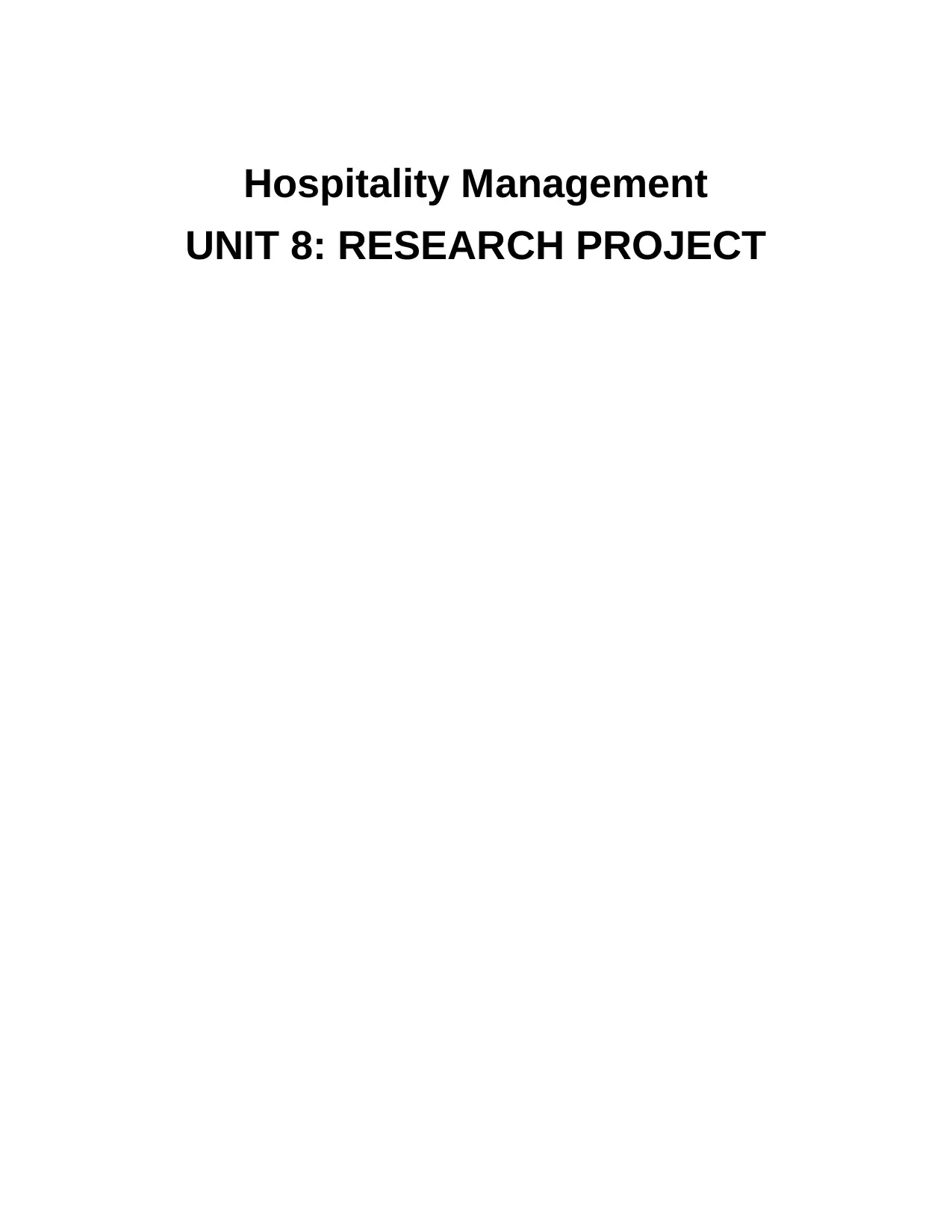
Hospitality Management
UNIT 8: RESEARCH PROJECT
UNIT 8: RESEARCH PROJECT
Paraphrase This Document
Need a fresh take? Get an instant paraphrase of this document with our AI Paraphraser
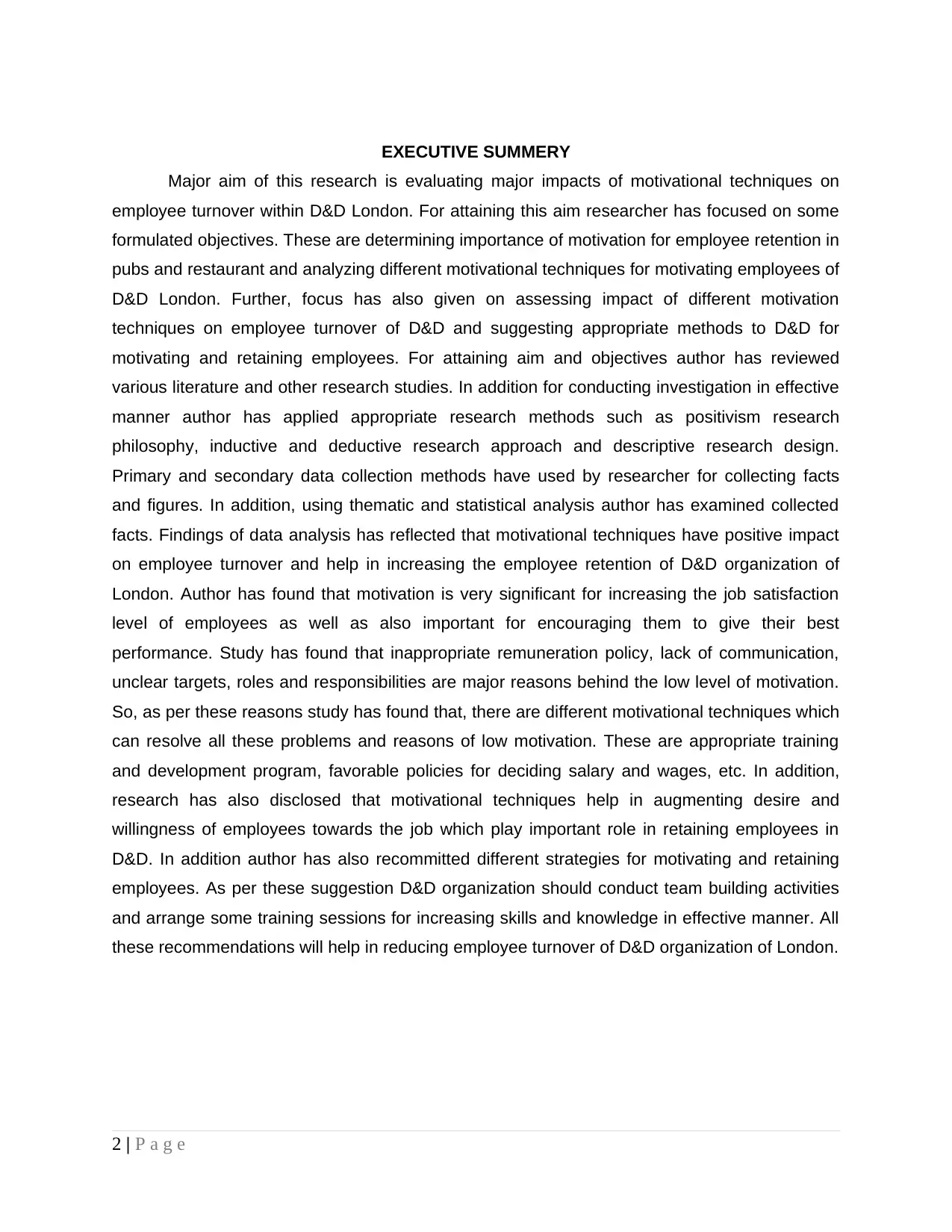
EXECUTIVE SUMMERY
Major aim of this research is evaluating major impacts of motivational techniques on
employee turnover within D&D London. For attaining this aim researcher has focused on some
formulated objectives. These are determining importance of motivation for employee retention in
pubs and restaurant and analyzing different motivational techniques for motivating employees of
D&D London. Further, focus has also given on assessing impact of different motivation
techniques on employee turnover of D&D and suggesting appropriate methods to D&D for
motivating and retaining employees. For attaining aim and objectives author has reviewed
various literature and other research studies. In addition for conducting investigation in effective
manner author has applied appropriate research methods such as positivism research
philosophy, inductive and deductive research approach and descriptive research design.
Primary and secondary data collection methods have used by researcher for collecting facts
and figures. In addition, using thematic and statistical analysis author has examined collected
facts. Findings of data analysis has reflected that motivational techniques have positive impact
on employee turnover and help in increasing the employee retention of D&D organization of
London. Author has found that motivation is very significant for increasing the job satisfaction
level of employees as well as also important for encouraging them to give their best
performance. Study has found that inappropriate remuneration policy, lack of communication,
unclear targets, roles and responsibilities are major reasons behind the low level of motivation.
So, as per these reasons study has found that, there are different motivational techniques which
can resolve all these problems and reasons of low motivation. These are appropriate training
and development program, favorable policies for deciding salary and wages, etc. In addition,
research has also disclosed that motivational techniques help in augmenting desire and
willingness of employees towards the job which play important role in retaining employees in
D&D. In addition author has also recommitted different strategies for motivating and retaining
employees. As per these suggestion D&D organization should conduct team building activities
and arrange some training sessions for increasing skills and knowledge in effective manner. All
these recommendations will help in reducing employee turnover of D&D organization of London.
2 | P a g e
Major aim of this research is evaluating major impacts of motivational techniques on
employee turnover within D&D London. For attaining this aim researcher has focused on some
formulated objectives. These are determining importance of motivation for employee retention in
pubs and restaurant and analyzing different motivational techniques for motivating employees of
D&D London. Further, focus has also given on assessing impact of different motivation
techniques on employee turnover of D&D and suggesting appropriate methods to D&D for
motivating and retaining employees. For attaining aim and objectives author has reviewed
various literature and other research studies. In addition for conducting investigation in effective
manner author has applied appropriate research methods such as positivism research
philosophy, inductive and deductive research approach and descriptive research design.
Primary and secondary data collection methods have used by researcher for collecting facts
and figures. In addition, using thematic and statistical analysis author has examined collected
facts. Findings of data analysis has reflected that motivational techniques have positive impact
on employee turnover and help in increasing the employee retention of D&D organization of
London. Author has found that motivation is very significant for increasing the job satisfaction
level of employees as well as also important for encouraging them to give their best
performance. Study has found that inappropriate remuneration policy, lack of communication,
unclear targets, roles and responsibilities are major reasons behind the low level of motivation.
So, as per these reasons study has found that, there are different motivational techniques which
can resolve all these problems and reasons of low motivation. These are appropriate training
and development program, favorable policies for deciding salary and wages, etc. In addition,
research has also disclosed that motivational techniques help in augmenting desire and
willingness of employees towards the job which play important role in retaining employees in
D&D. In addition author has also recommitted different strategies for motivating and retaining
employees. As per these suggestion D&D organization should conduct team building activities
and arrange some training sessions for increasing skills and knowledge in effective manner. All
these recommendations will help in reducing employee turnover of D&D organization of London.
2 | P a g e
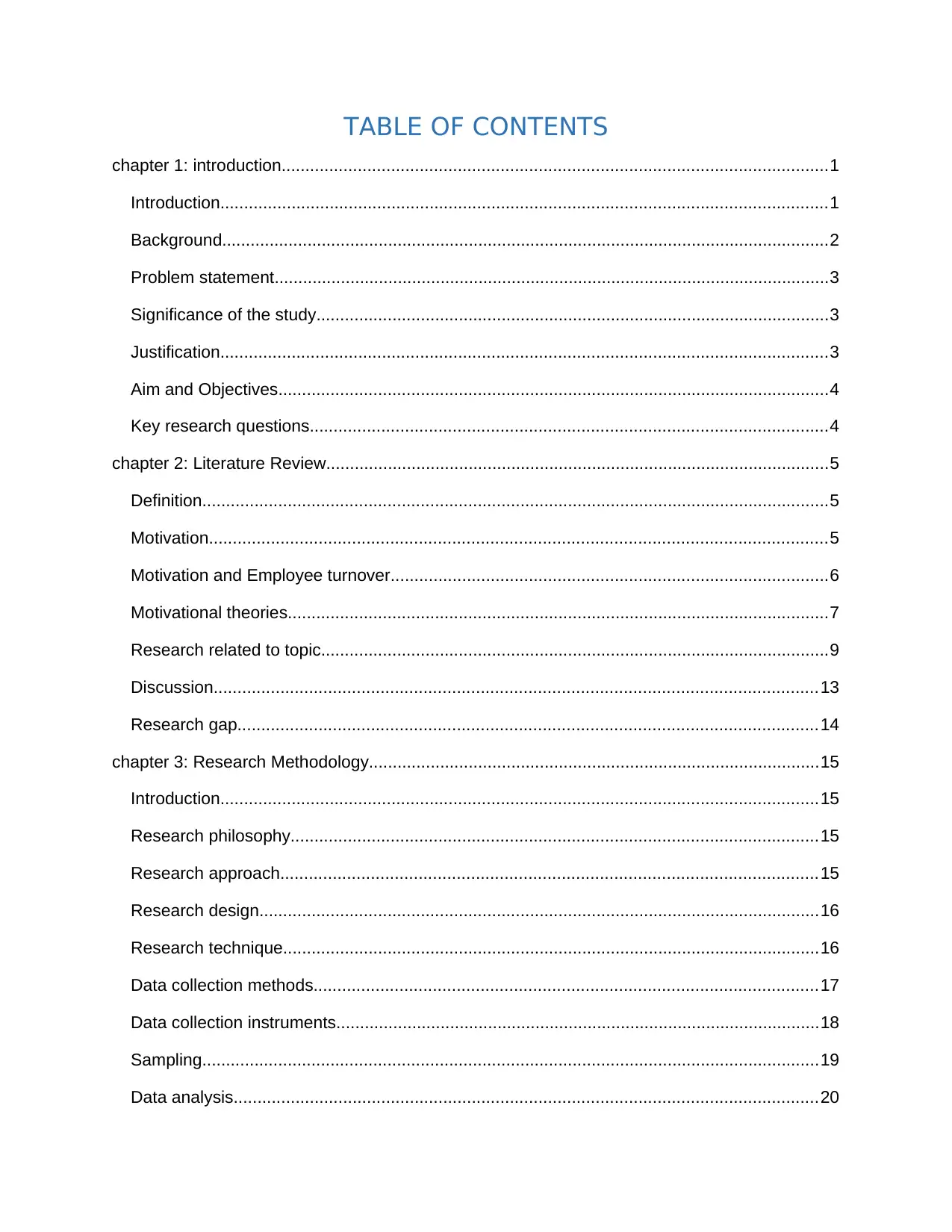
TABLE OF CONTENTS
chapter 1: introduction...................................................................................................................1
Introduction................................................................................................................................1
Background................................................................................................................................2
Problem statement.....................................................................................................................3
Significance of the study............................................................................................................3
Justification................................................................................................................................3
Aim and Objectives....................................................................................................................4
Key research questions.............................................................................................................4
chapter 2: Literature Review..........................................................................................................5
Definition....................................................................................................................................5
Motivation..................................................................................................................................5
Motivation and Employee turnover............................................................................................6
Motivational theories..................................................................................................................7
Research related to topic...........................................................................................................9
Discussion...............................................................................................................................13
Research gap..........................................................................................................................14
chapter 3: Research Methodology...............................................................................................15
Introduction..............................................................................................................................15
Research philosophy...............................................................................................................15
Research approach.................................................................................................................15
Research design......................................................................................................................16
Research technique.................................................................................................................16
Data collection methods..........................................................................................................17
Data collection instruments......................................................................................................18
Sampling..................................................................................................................................19
Data analysis...........................................................................................................................20
chapter 1: introduction...................................................................................................................1
Introduction................................................................................................................................1
Background................................................................................................................................2
Problem statement.....................................................................................................................3
Significance of the study............................................................................................................3
Justification................................................................................................................................3
Aim and Objectives....................................................................................................................4
Key research questions.............................................................................................................4
chapter 2: Literature Review..........................................................................................................5
Definition....................................................................................................................................5
Motivation..................................................................................................................................5
Motivation and Employee turnover............................................................................................6
Motivational theories..................................................................................................................7
Research related to topic...........................................................................................................9
Discussion...............................................................................................................................13
Research gap..........................................................................................................................14
chapter 3: Research Methodology...............................................................................................15
Introduction..............................................................................................................................15
Research philosophy...............................................................................................................15
Research approach.................................................................................................................15
Research design......................................................................................................................16
Research technique.................................................................................................................16
Data collection methods..........................................................................................................17
Data collection instruments......................................................................................................18
Sampling..................................................................................................................................19
Data analysis...........................................................................................................................20
⊘ This is a preview!⊘
Do you want full access?
Subscribe today to unlock all pages.

Trusted by 1+ million students worldwide
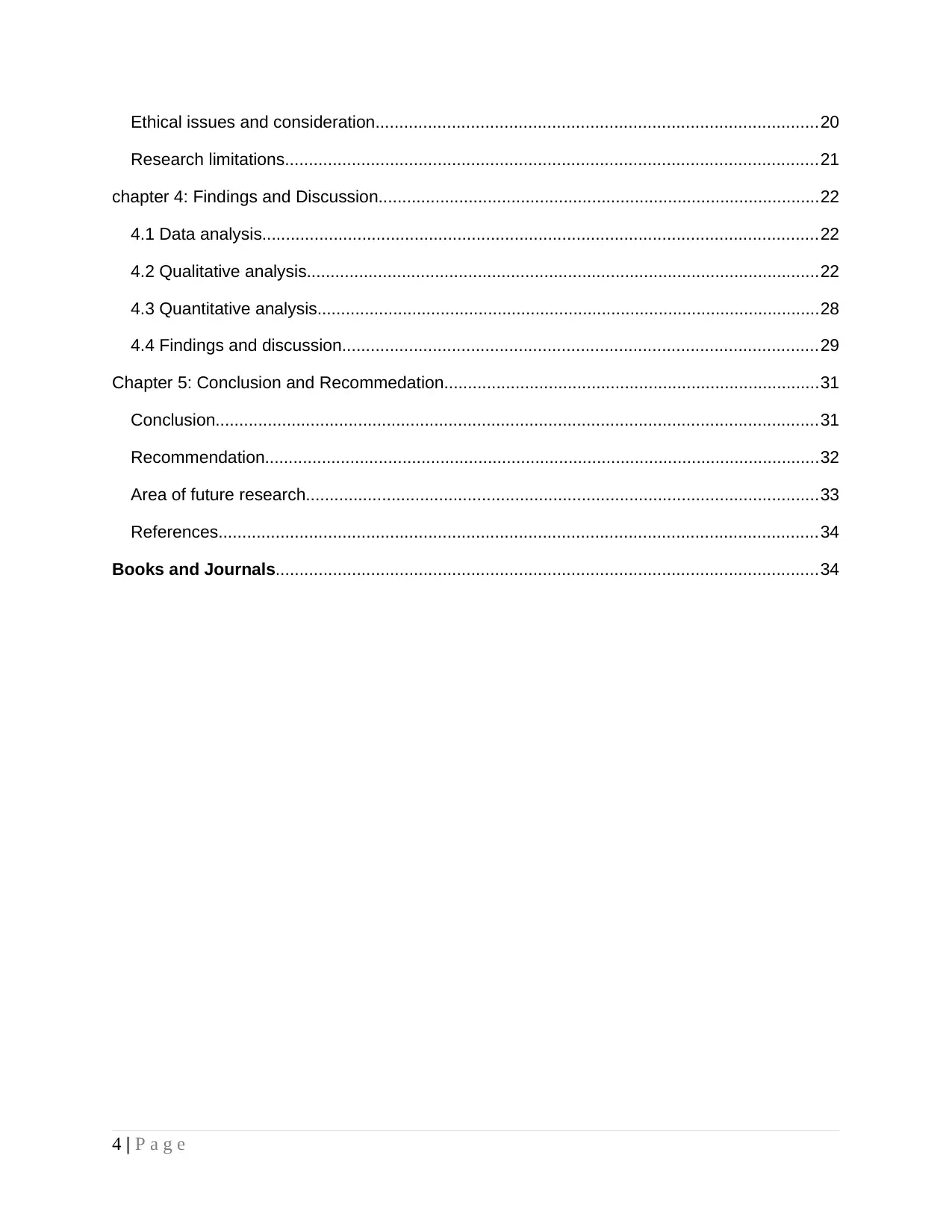
Ethical issues and consideration.............................................................................................20
Research limitations................................................................................................................21
chapter 4: Findings and Discussion.............................................................................................22
4.1 Data analysis.....................................................................................................................22
4.2 Qualitative analysis............................................................................................................22
4.3 Quantitative analysis..........................................................................................................28
4.4 Findings and discussion....................................................................................................29
Chapter 5: Conclusion and Recommedation...............................................................................31
Conclusion...............................................................................................................................31
Recommendation.....................................................................................................................32
Area of future research............................................................................................................33
References..............................................................................................................................34
Books and Journals..................................................................................................................34
4 | P a g e
Research limitations................................................................................................................21
chapter 4: Findings and Discussion.............................................................................................22
4.1 Data analysis.....................................................................................................................22
4.2 Qualitative analysis............................................................................................................22
4.3 Quantitative analysis..........................................................................................................28
4.4 Findings and discussion....................................................................................................29
Chapter 5: Conclusion and Recommedation...............................................................................31
Conclusion...............................................................................................................................31
Recommendation.....................................................................................................................32
Area of future research............................................................................................................33
References..............................................................................................................................34
Books and Journals..................................................................................................................34
4 | P a g e
Paraphrase This Document
Need a fresh take? Get an instant paraphrase of this document with our AI Paraphraser
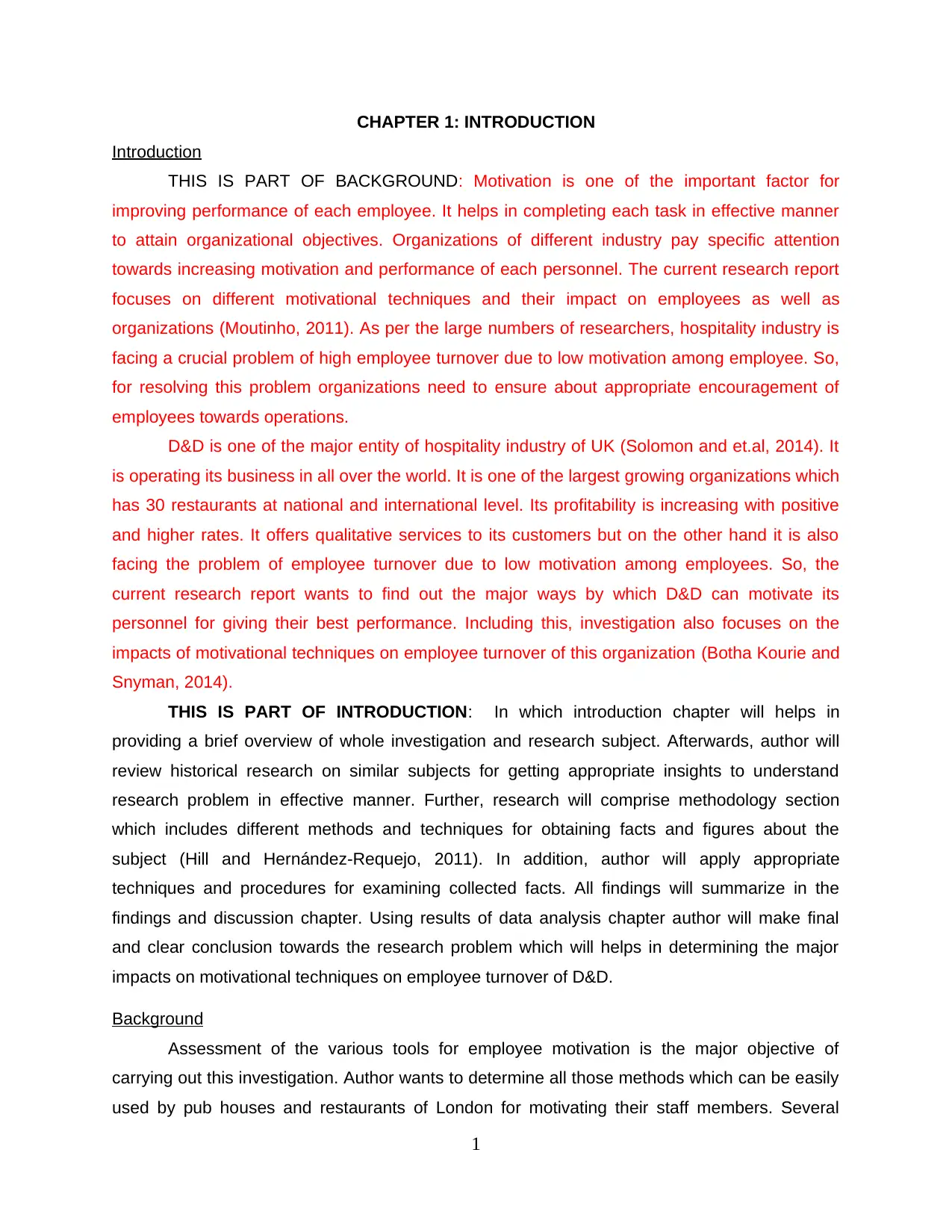
CHAPTER 1: INTRODUCTION
Introduction
THIS IS PART OF BACKGROUND: Motivation is one of the important factor for
improving performance of each employee. It helps in completing each task in effective manner
to attain organizational objectives. Organizations of different industry pay specific attention
towards increasing motivation and performance of each personnel. The current research report
focuses on different motivational techniques and their impact on employees as well as
organizations (Moutinho, 2011). As per the large numbers of researchers, hospitality industry is
facing a crucial problem of high employee turnover due to low motivation among employee. So,
for resolving this problem organizations need to ensure about appropriate encouragement of
employees towards operations.
D&D is one of the major entity of hospitality industry of UK (Solomon and et.al, 2014). It
is operating its business in all over the world. It is one of the largest growing organizations which
has 30 restaurants at national and international level. Its profitability is increasing with positive
and higher rates. It offers qualitative services to its customers but on the other hand it is also
facing the problem of employee turnover due to low motivation among employees. So, the
current research report wants to find out the major ways by which D&D can motivate its
personnel for giving their best performance. Including this, investigation also focuses on the
impacts of motivational techniques on employee turnover of this organization (Botha Kourie and
Snyman, 2014).
THIS IS PART OF INTRODUCTION: In which introduction chapter will helps in
providing a brief overview of whole investigation and research subject. Afterwards, author will
review historical research on similar subjects for getting appropriate insights to understand
research problem in effective manner. Further, research will comprise methodology section
which includes different methods and techniques for obtaining facts and figures about the
subject (Hill and Hernández-Requejo, 2011). In addition, author will apply appropriate
techniques and procedures for examining collected facts. All findings will summarize in the
findings and discussion chapter. Using results of data analysis chapter author will make final
and clear conclusion towards the research problem which will helps in determining the major
impacts on motivational techniques on employee turnover of D&D.
Background
Assessment of the various tools for employee motivation is the major objective of
carrying out this investigation. Author wants to determine all those methods which can be easily
used by pub houses and restaurants of London for motivating their staff members. Several
1
Introduction
THIS IS PART OF BACKGROUND: Motivation is one of the important factor for
improving performance of each employee. It helps in completing each task in effective manner
to attain organizational objectives. Organizations of different industry pay specific attention
towards increasing motivation and performance of each personnel. The current research report
focuses on different motivational techniques and their impact on employees as well as
organizations (Moutinho, 2011). As per the large numbers of researchers, hospitality industry is
facing a crucial problem of high employee turnover due to low motivation among employee. So,
for resolving this problem organizations need to ensure about appropriate encouragement of
employees towards operations.
D&D is one of the major entity of hospitality industry of UK (Solomon and et.al, 2014). It
is operating its business in all over the world. It is one of the largest growing organizations which
has 30 restaurants at national and international level. Its profitability is increasing with positive
and higher rates. It offers qualitative services to its customers but on the other hand it is also
facing the problem of employee turnover due to low motivation among employees. So, the
current research report wants to find out the major ways by which D&D can motivate its
personnel for giving their best performance. Including this, investigation also focuses on the
impacts of motivational techniques on employee turnover of this organization (Botha Kourie and
Snyman, 2014).
THIS IS PART OF INTRODUCTION: In which introduction chapter will helps in
providing a brief overview of whole investigation and research subject. Afterwards, author will
review historical research on similar subjects for getting appropriate insights to understand
research problem in effective manner. Further, research will comprise methodology section
which includes different methods and techniques for obtaining facts and figures about the
subject (Hill and Hernández-Requejo, 2011). In addition, author will apply appropriate
techniques and procedures for examining collected facts. All findings will summarize in the
findings and discussion chapter. Using results of data analysis chapter author will make final
and clear conclusion towards the research problem which will helps in determining the major
impacts on motivational techniques on employee turnover of D&D.
Background
Assessment of the various tools for employee motivation is the major objective of
carrying out this investigation. Author wants to determine all those methods which can be easily
used by pub houses and restaurants of London for motivating their staff members. Several
1
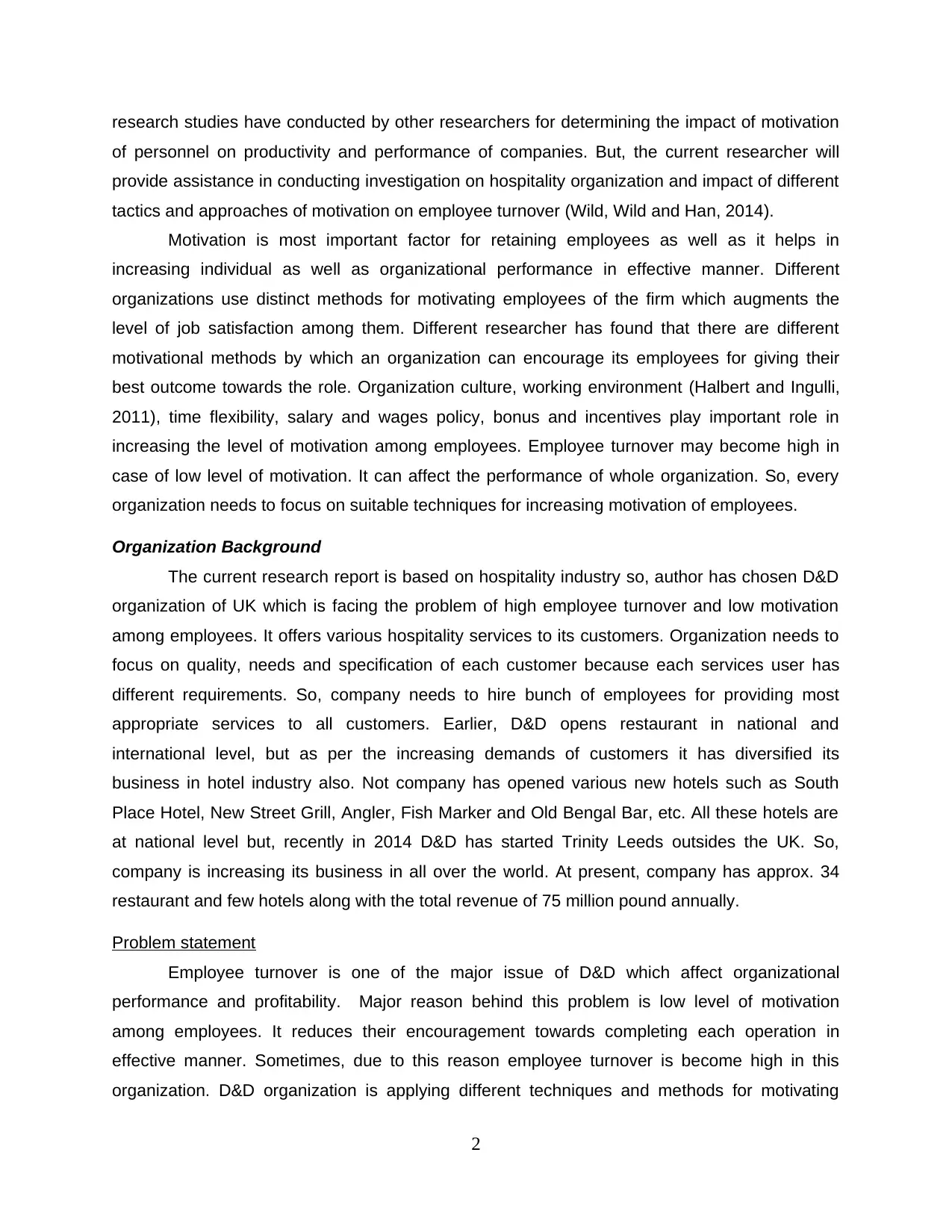
research studies have conducted by other researchers for determining the impact of motivation
of personnel on productivity and performance of companies. But, the current researcher will
provide assistance in conducting investigation on hospitality organization and impact of different
tactics and approaches of motivation on employee turnover (Wild, Wild and Han, 2014).
Motivation is most important factor for retaining employees as well as it helps in
increasing individual as well as organizational performance in effective manner. Different
organizations use distinct methods for motivating employees of the firm which augments the
level of job satisfaction among them. Different researcher has found that there are different
motivational methods by which an organization can encourage its employees for giving their
best outcome towards the role. Organization culture, working environment (Halbert and Ingulli,
2011), time flexibility, salary and wages policy, bonus and incentives play important role in
increasing the level of motivation among employees. Employee turnover may become high in
case of low level of motivation. It can affect the performance of whole organization. So, every
organization needs to focus on suitable techniques for increasing motivation of employees.
Organization Background
The current research report is based on hospitality industry so, author has chosen D&D
organization of UK which is facing the problem of high employee turnover and low motivation
among employees. It offers various hospitality services to its customers. Organization needs to
focus on quality, needs and specification of each customer because each services user has
different requirements. So, company needs to hire bunch of employees for providing most
appropriate services to all customers. Earlier, D&D opens restaurant in national and
international level, but as per the increasing demands of customers it has diversified its
business in hotel industry also. Not company has opened various new hotels such as South
Place Hotel, New Street Grill, Angler, Fish Marker and Old Bengal Bar, etc. All these hotels are
at national level but, recently in 2014 D&D has started Trinity Leeds outsides the UK. So,
company is increasing its business in all over the world. At present, company has approx. 34
restaurant and few hotels along with the total revenue of 75 million pound annually.
Problem statement
Employee turnover is one of the major issue of D&D which affect organizational
performance and profitability. Major reason behind this problem is low level of motivation
among employees. It reduces their encouragement towards completing each operation in
effective manner. Sometimes, due to this reason employee turnover is become high in this
organization. D&D organization is applying different techniques and methods for motivating
2
of personnel on productivity and performance of companies. But, the current researcher will
provide assistance in conducting investigation on hospitality organization and impact of different
tactics and approaches of motivation on employee turnover (Wild, Wild and Han, 2014).
Motivation is most important factor for retaining employees as well as it helps in
increasing individual as well as organizational performance in effective manner. Different
organizations use distinct methods for motivating employees of the firm which augments the
level of job satisfaction among them. Different researcher has found that there are different
motivational methods by which an organization can encourage its employees for giving their
best outcome towards the role. Organization culture, working environment (Halbert and Ingulli,
2011), time flexibility, salary and wages policy, bonus and incentives play important role in
increasing the level of motivation among employees. Employee turnover may become high in
case of low level of motivation. It can affect the performance of whole organization. So, every
organization needs to focus on suitable techniques for increasing motivation of employees.
Organization Background
The current research report is based on hospitality industry so, author has chosen D&D
organization of UK which is facing the problem of high employee turnover and low motivation
among employees. It offers various hospitality services to its customers. Organization needs to
focus on quality, needs and specification of each customer because each services user has
different requirements. So, company needs to hire bunch of employees for providing most
appropriate services to all customers. Earlier, D&D opens restaurant in national and
international level, but as per the increasing demands of customers it has diversified its
business in hotel industry also. Not company has opened various new hotels such as South
Place Hotel, New Street Grill, Angler, Fish Marker and Old Bengal Bar, etc. All these hotels are
at national level but, recently in 2014 D&D has started Trinity Leeds outsides the UK. So,
company is increasing its business in all over the world. At present, company has approx. 34
restaurant and few hotels along with the total revenue of 75 million pound annually.
Problem statement
Employee turnover is one of the major issue of D&D which affect organizational
performance and profitability. Major reason behind this problem is low level of motivation
among employees. It reduces their encouragement towards completing each operation in
effective manner. Sometimes, due to this reason employee turnover is become high in this
organization. D&D organization is applying different techniques and methods for motivating
2
⊘ This is a preview!⊘
Do you want full access?
Subscribe today to unlock all pages.

Trusted by 1+ million students worldwide
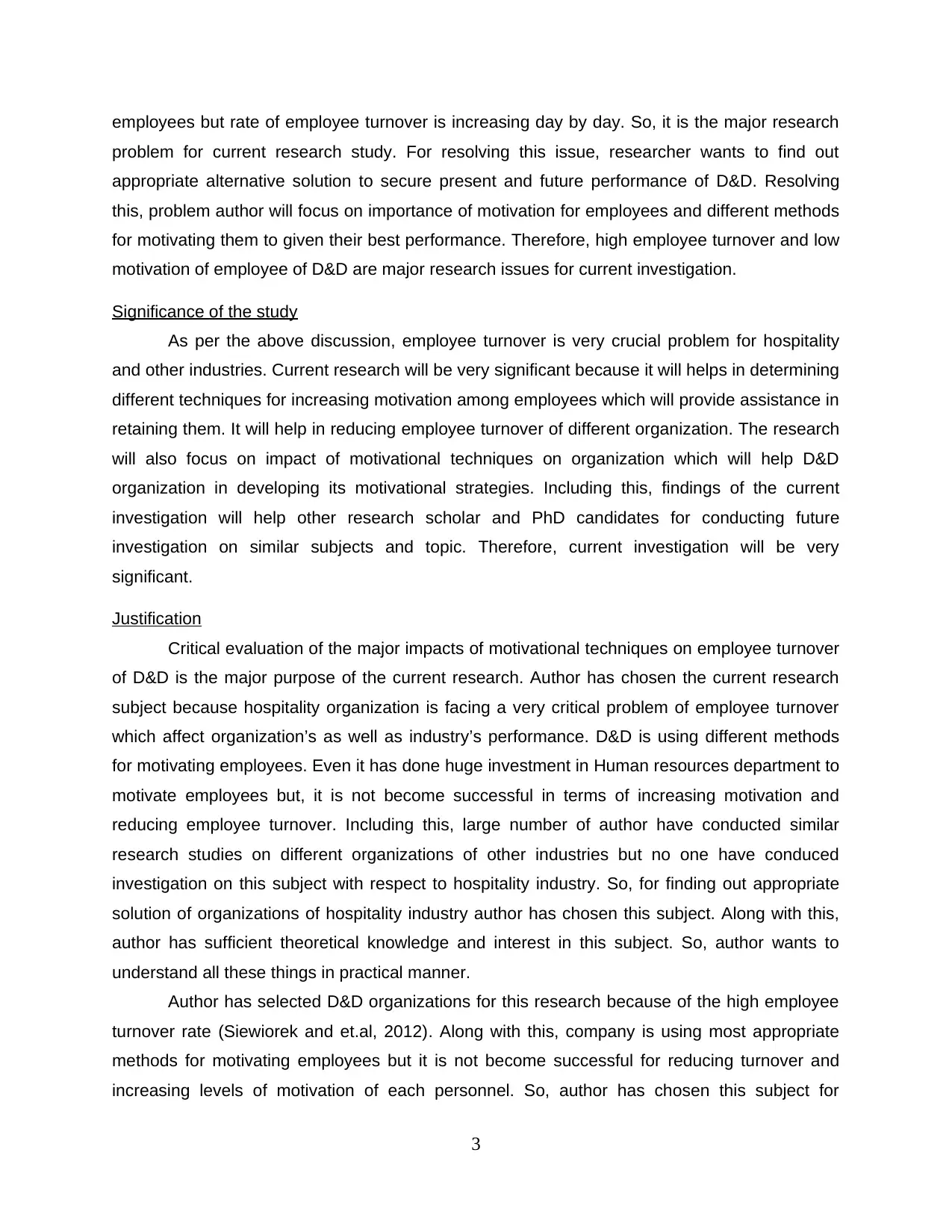
employees but rate of employee turnover is increasing day by day. So, it is the major research
problem for current research study. For resolving this issue, researcher wants to find out
appropriate alternative solution to secure present and future performance of D&D. Resolving
this, problem author will focus on importance of motivation for employees and different methods
for motivating them to given their best performance. Therefore, high employee turnover and low
motivation of employee of D&D are major research issues for current investigation.
Significance of the study
As per the above discussion, employee turnover is very crucial problem for hospitality
and other industries. Current research will be very significant because it will helps in determining
different techniques for increasing motivation among employees which will provide assistance in
retaining them. It will help in reducing employee turnover of different organization. The research
will also focus on impact of motivational techniques on organization which will help D&D
organization in developing its motivational strategies. Including this, findings of the current
investigation will help other research scholar and PhD candidates for conducting future
investigation on similar subjects and topic. Therefore, current investigation will be very
significant.
Justification
Critical evaluation of the major impacts of motivational techniques on employee turnover
of D&D is the major purpose of the current research. Author has chosen the current research
subject because hospitality organization is facing a very critical problem of employee turnover
which affect organization’s as well as industry’s performance. D&D is using different methods
for motivating employees. Even it has done huge investment in Human resources department to
motivate employees but, it is not become successful in terms of increasing motivation and
reducing employee turnover. Including this, large number of author have conducted similar
research studies on different organizations of other industries but no one have conduced
investigation on this subject with respect to hospitality industry. So, for finding out appropriate
solution of organizations of hospitality industry author has chosen this subject. Along with this,
author has sufficient theoretical knowledge and interest in this subject. So, author wants to
understand all these things in practical manner.
Author has selected D&D organizations for this research because of the high employee
turnover rate (Siewiorek and et.al, 2012). Along with this, company is using most appropriate
methods for motivating employees but it is not become successful for reducing turnover and
increasing levels of motivation of each personnel. So, author has chosen this subject for
3
problem for current research study. For resolving this issue, researcher wants to find out
appropriate alternative solution to secure present and future performance of D&D. Resolving
this, problem author will focus on importance of motivation for employees and different methods
for motivating them to given their best performance. Therefore, high employee turnover and low
motivation of employee of D&D are major research issues for current investigation.
Significance of the study
As per the above discussion, employee turnover is very crucial problem for hospitality
and other industries. Current research will be very significant because it will helps in determining
different techniques for increasing motivation among employees which will provide assistance in
retaining them. It will help in reducing employee turnover of different organization. The research
will also focus on impact of motivational techniques on organization which will help D&D
organization in developing its motivational strategies. Including this, findings of the current
investigation will help other research scholar and PhD candidates for conducting future
investigation on similar subjects and topic. Therefore, current investigation will be very
significant.
Justification
Critical evaluation of the major impacts of motivational techniques on employee turnover
of D&D is the major purpose of the current research. Author has chosen the current research
subject because hospitality organization is facing a very critical problem of employee turnover
which affect organization’s as well as industry’s performance. D&D is using different methods
for motivating employees. Even it has done huge investment in Human resources department to
motivate employees but, it is not become successful in terms of increasing motivation and
reducing employee turnover. Including this, large number of author have conducted similar
research studies on different organizations of other industries but no one have conduced
investigation on this subject with respect to hospitality industry. So, for finding out appropriate
solution of organizations of hospitality industry author has chosen this subject. Along with this,
author has sufficient theoretical knowledge and interest in this subject. So, author wants to
understand all these things in practical manner.
Author has selected D&D organizations for this research because of the high employee
turnover rate (Siewiorek and et.al, 2012). Along with this, company is using most appropriate
methods for motivating employees but it is not become successful for reducing turnover and
increasing levels of motivation of each personnel. So, author has chosen this subject for
3
Paraphrase This Document
Need a fresh take? Get an instant paraphrase of this document with our AI Paraphraser
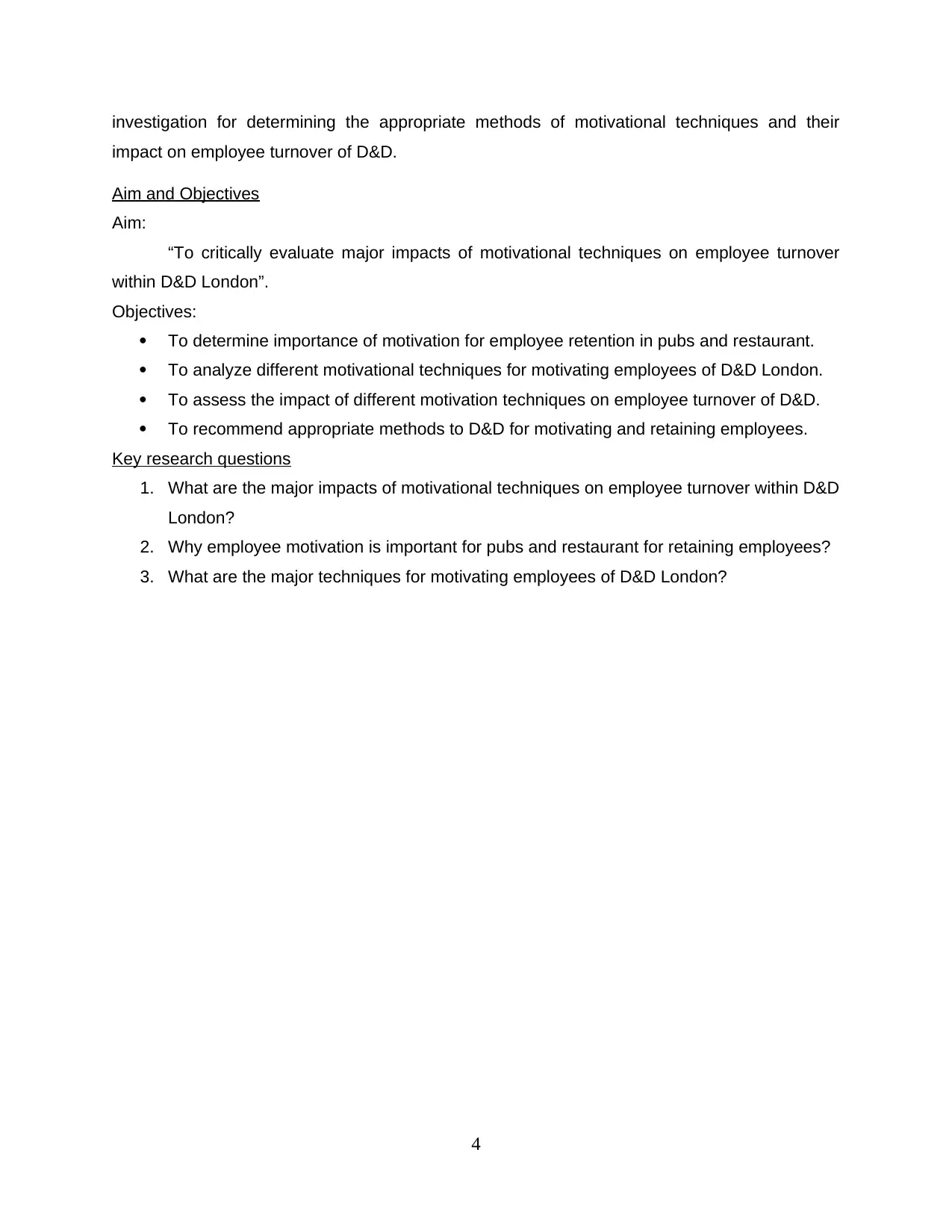
investigation for determining the appropriate methods of motivational techniques and their
impact on employee turnover of D&D.
Aim and Objectives
Aim:
“To critically evaluate major impacts of motivational techniques on employee turnover
within D&D London”.
Objectives:
To determine importance of motivation for employee retention in pubs and restaurant.
To analyze different motivational techniques for motivating employees of D&D London.
To assess the impact of different motivation techniques on employee turnover of D&D.
To recommend appropriate methods to D&D for motivating and retaining employees.
Key research questions
1. What are the major impacts of motivational techniques on employee turnover within D&D
London?
2. Why employee motivation is important for pubs and restaurant for retaining employees?
3. What are the major techniques for motivating employees of D&D London?
4
impact on employee turnover of D&D.
Aim and Objectives
Aim:
“To critically evaluate major impacts of motivational techniques on employee turnover
within D&D London”.
Objectives:
To determine importance of motivation for employee retention in pubs and restaurant.
To analyze different motivational techniques for motivating employees of D&D London.
To assess the impact of different motivation techniques on employee turnover of D&D.
To recommend appropriate methods to D&D for motivating and retaining employees.
Key research questions
1. What are the major impacts of motivational techniques on employee turnover within D&D
London?
2. Why employee motivation is important for pubs and restaurant for retaining employees?
3. What are the major techniques for motivating employees of D&D London?
4
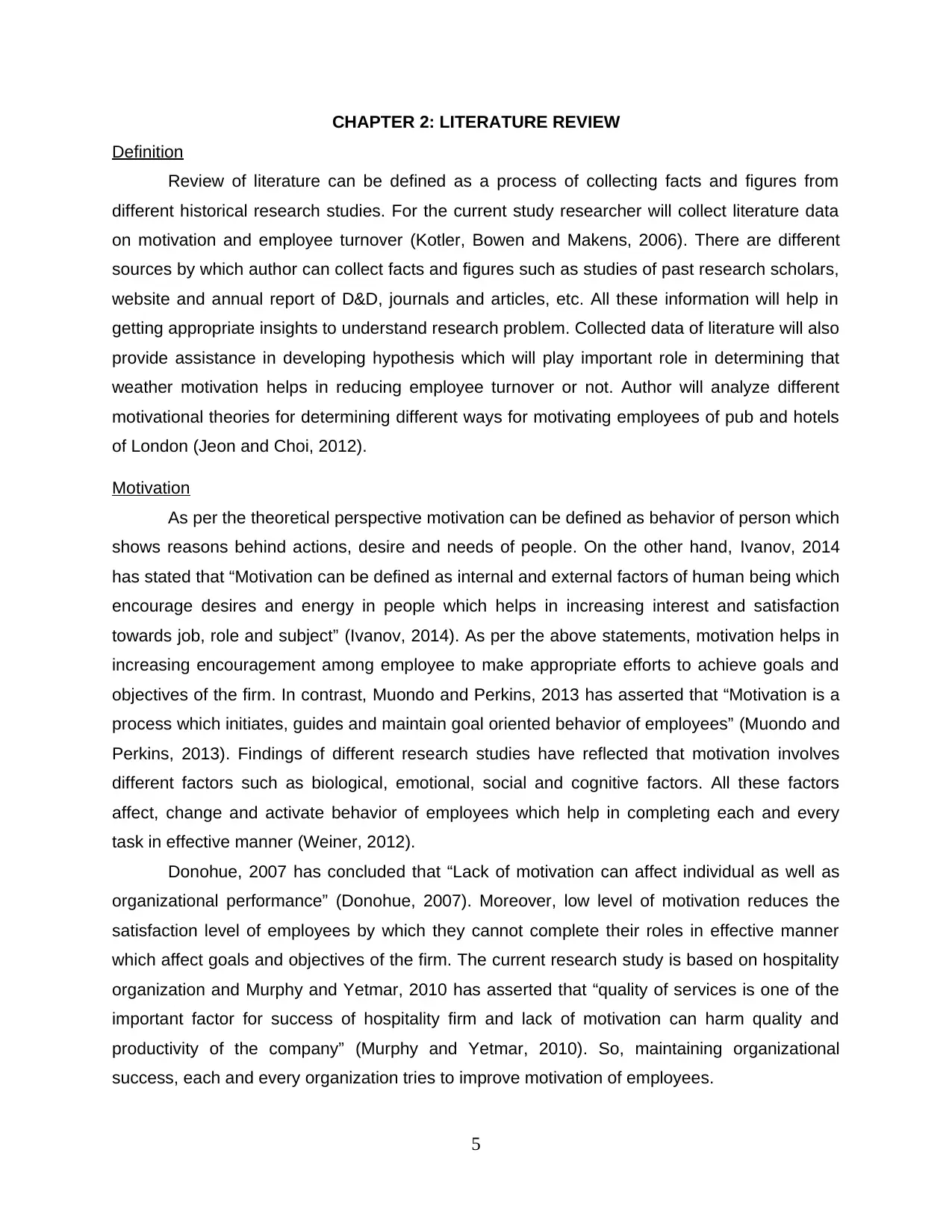
CHAPTER 2: LITERATURE REVIEW
Definition
Review of literature can be defined as a process of collecting facts and figures from
different historical research studies. For the current study researcher will collect literature data
on motivation and employee turnover (Kotler, Bowen and Makens, 2006). There are different
sources by which author can collect facts and figures such as studies of past research scholars,
website and annual report of D&D, journals and articles, etc. All these information will help in
getting appropriate insights to understand research problem. Collected data of literature will also
provide assistance in developing hypothesis which will play important role in determining that
weather motivation helps in reducing employee turnover or not. Author will analyze different
motivational theories for determining different ways for motivating employees of pub and hotels
of London (Jeon and Choi, 2012).
Motivation
As per the theoretical perspective motivation can be defined as behavior of person which
shows reasons behind actions, desire and needs of people. On the other hand, Ivanov, 2014
has stated that “Motivation can be defined as internal and external factors of human being which
encourage desires and energy in people which helps in increasing interest and satisfaction
towards job, role and subject” (Ivanov, 2014). As per the above statements, motivation helps in
increasing encouragement among employee to make appropriate efforts to achieve goals and
objectives of the firm. In contrast, Muondo and Perkins, 2013 has asserted that “Motivation is a
process which initiates, guides and maintain goal oriented behavior of employees” (Muondo and
Perkins, 2013). Findings of different research studies have reflected that motivation involves
different factors such as biological, emotional, social and cognitive factors. All these factors
affect, change and activate behavior of employees which help in completing each and every
task in effective manner (Weiner, 2012).
Donohue, 2007 has concluded that “Lack of motivation can affect individual as well as
organizational performance” (Donohue, 2007). Moreover, low level of motivation reduces the
satisfaction level of employees by which they cannot complete their roles in effective manner
which affect goals and objectives of the firm. The current research study is based on hospitality
organization and Murphy and Yetmar, 2010 has asserted that “quality of services is one of the
important factor for success of hospitality firm and lack of motivation can harm quality and
productivity of the company” (Murphy and Yetmar, 2010). So, maintaining organizational
success, each and every organization tries to improve motivation of employees.
5
Definition
Review of literature can be defined as a process of collecting facts and figures from
different historical research studies. For the current study researcher will collect literature data
on motivation and employee turnover (Kotler, Bowen and Makens, 2006). There are different
sources by which author can collect facts and figures such as studies of past research scholars,
website and annual report of D&D, journals and articles, etc. All these information will help in
getting appropriate insights to understand research problem. Collected data of literature will also
provide assistance in developing hypothesis which will play important role in determining that
weather motivation helps in reducing employee turnover or not. Author will analyze different
motivational theories for determining different ways for motivating employees of pub and hotels
of London (Jeon and Choi, 2012).
Motivation
As per the theoretical perspective motivation can be defined as behavior of person which
shows reasons behind actions, desire and needs of people. On the other hand, Ivanov, 2014
has stated that “Motivation can be defined as internal and external factors of human being which
encourage desires and energy in people which helps in increasing interest and satisfaction
towards job, role and subject” (Ivanov, 2014). As per the above statements, motivation helps in
increasing encouragement among employee to make appropriate efforts to achieve goals and
objectives of the firm. In contrast, Muondo and Perkins, 2013 has asserted that “Motivation is a
process which initiates, guides and maintain goal oriented behavior of employees” (Muondo and
Perkins, 2013). Findings of different research studies have reflected that motivation involves
different factors such as biological, emotional, social and cognitive factors. All these factors
affect, change and activate behavior of employees which help in completing each and every
task in effective manner (Weiner, 2012).
Donohue, 2007 has concluded that “Lack of motivation can affect individual as well as
organizational performance” (Donohue, 2007). Moreover, low level of motivation reduces the
satisfaction level of employees by which they cannot complete their roles in effective manner
which affect goals and objectives of the firm. The current research study is based on hospitality
organization and Murphy and Yetmar, 2010 has asserted that “quality of services is one of the
important factor for success of hospitality firm and lack of motivation can harm quality and
productivity of the company” (Murphy and Yetmar, 2010). So, maintaining organizational
success, each and every organization tries to improve motivation of employees.
5
⊘ This is a preview!⊘
Do you want full access?
Subscribe today to unlock all pages.

Trusted by 1+ million students worldwide
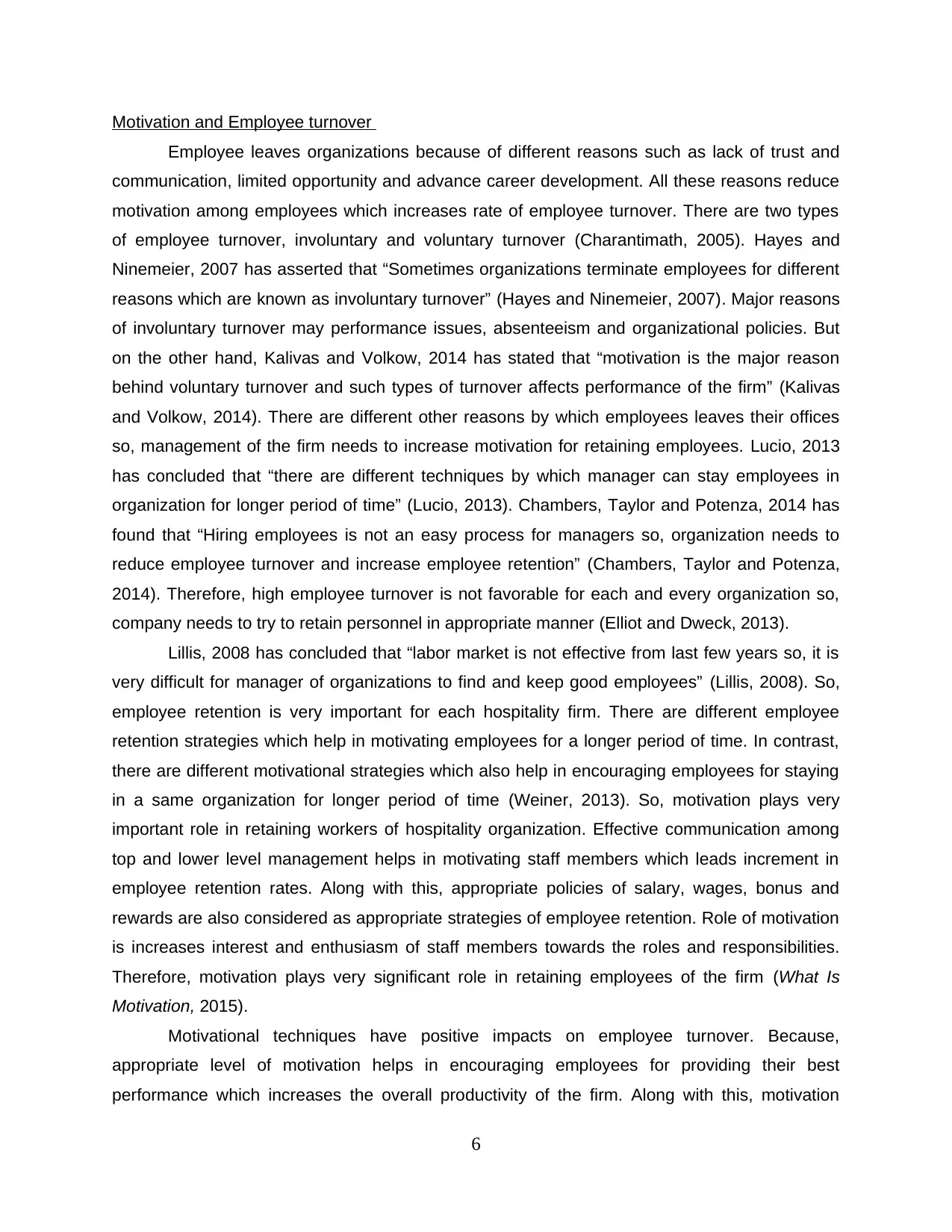
Motivation and Employee turnover
Employee leaves organizations because of different reasons such as lack of trust and
communication, limited opportunity and advance career development. All these reasons reduce
motivation among employees which increases rate of employee turnover. There are two types
of employee turnover, involuntary and voluntary turnover (Charantimath, 2005). Hayes and
Ninemeier, 2007 has asserted that “Sometimes organizations terminate employees for different
reasons which are known as involuntary turnover” (Hayes and Ninemeier, 2007). Major reasons
of involuntary turnover may performance issues, absenteeism and organizational policies. But
on the other hand, Kalivas and Volkow, 2014 has stated that “motivation is the major reason
behind voluntary turnover and such types of turnover affects performance of the firm” (Kalivas
and Volkow, 2014). There are different other reasons by which employees leaves their offices
so, management of the firm needs to increase motivation for retaining employees. Lucio, 2013
has concluded that “there are different techniques by which manager can stay employees in
organization for longer period of time” (Lucio, 2013). Chambers, Taylor and Potenza, 2014 has
found that “Hiring employees is not an easy process for managers so, organization needs to
reduce employee turnover and increase employee retention” (Chambers, Taylor and Potenza,
2014). Therefore, high employee turnover is not favorable for each and every organization so,
company needs to try to retain personnel in appropriate manner (Elliot and Dweck, 2013).
Lillis, 2008 has concluded that “labor market is not effective from last few years so, it is
very difficult for manager of organizations to find and keep good employees” (Lillis, 2008). So,
employee retention is very important for each hospitality firm. There are different employee
retention strategies which help in motivating employees for a longer period of time. In contrast,
there are different motivational strategies which also help in encouraging employees for staying
in a same organization for longer period of time (Weiner, 2013). So, motivation plays very
important role in retaining workers of hospitality organization. Effective communication among
top and lower level management helps in motivating staff members which leads increment in
employee retention rates. Along with this, appropriate policies of salary, wages, bonus and
rewards are also considered as appropriate strategies of employee retention. Role of motivation
is increases interest and enthusiasm of staff members towards the roles and responsibilities.
Therefore, motivation plays very significant role in retaining employees of the firm (What Is
Motivation, 2015).
Motivational techniques have positive impacts on employee turnover. Because,
appropriate level of motivation helps in encouraging employees for providing their best
performance which increases the overall productivity of the firm. Along with this, motivation
6
Employee leaves organizations because of different reasons such as lack of trust and
communication, limited opportunity and advance career development. All these reasons reduce
motivation among employees which increases rate of employee turnover. There are two types
of employee turnover, involuntary and voluntary turnover (Charantimath, 2005). Hayes and
Ninemeier, 2007 has asserted that “Sometimes organizations terminate employees for different
reasons which are known as involuntary turnover” (Hayes and Ninemeier, 2007). Major reasons
of involuntary turnover may performance issues, absenteeism and organizational policies. But
on the other hand, Kalivas and Volkow, 2014 has stated that “motivation is the major reason
behind voluntary turnover and such types of turnover affects performance of the firm” (Kalivas
and Volkow, 2014). There are different other reasons by which employees leaves their offices
so, management of the firm needs to increase motivation for retaining employees. Lucio, 2013
has concluded that “there are different techniques by which manager can stay employees in
organization for longer period of time” (Lucio, 2013). Chambers, Taylor and Potenza, 2014 has
found that “Hiring employees is not an easy process for managers so, organization needs to
reduce employee turnover and increase employee retention” (Chambers, Taylor and Potenza,
2014). Therefore, high employee turnover is not favorable for each and every organization so,
company needs to try to retain personnel in appropriate manner (Elliot and Dweck, 2013).
Lillis, 2008 has concluded that “labor market is not effective from last few years so, it is
very difficult for manager of organizations to find and keep good employees” (Lillis, 2008). So,
employee retention is very important for each hospitality firm. There are different employee
retention strategies which help in motivating employees for a longer period of time. In contrast,
there are different motivational strategies which also help in encouraging employees for staying
in a same organization for longer period of time (Weiner, 2013). So, motivation plays very
important role in retaining workers of hospitality organization. Effective communication among
top and lower level management helps in motivating staff members which leads increment in
employee retention rates. Along with this, appropriate policies of salary, wages, bonus and
rewards are also considered as appropriate strategies of employee retention. Role of motivation
is increases interest and enthusiasm of staff members towards the roles and responsibilities.
Therefore, motivation plays very significant role in retaining employees of the firm (What Is
Motivation, 2015).
Motivational techniques have positive impacts on employee turnover. Because,
appropriate level of motivation helps in encouraging employees for providing their best
performance which increases the overall productivity of the firm. Along with this, motivation
6
Paraphrase This Document
Need a fresh take? Get an instant paraphrase of this document with our AI Paraphraser
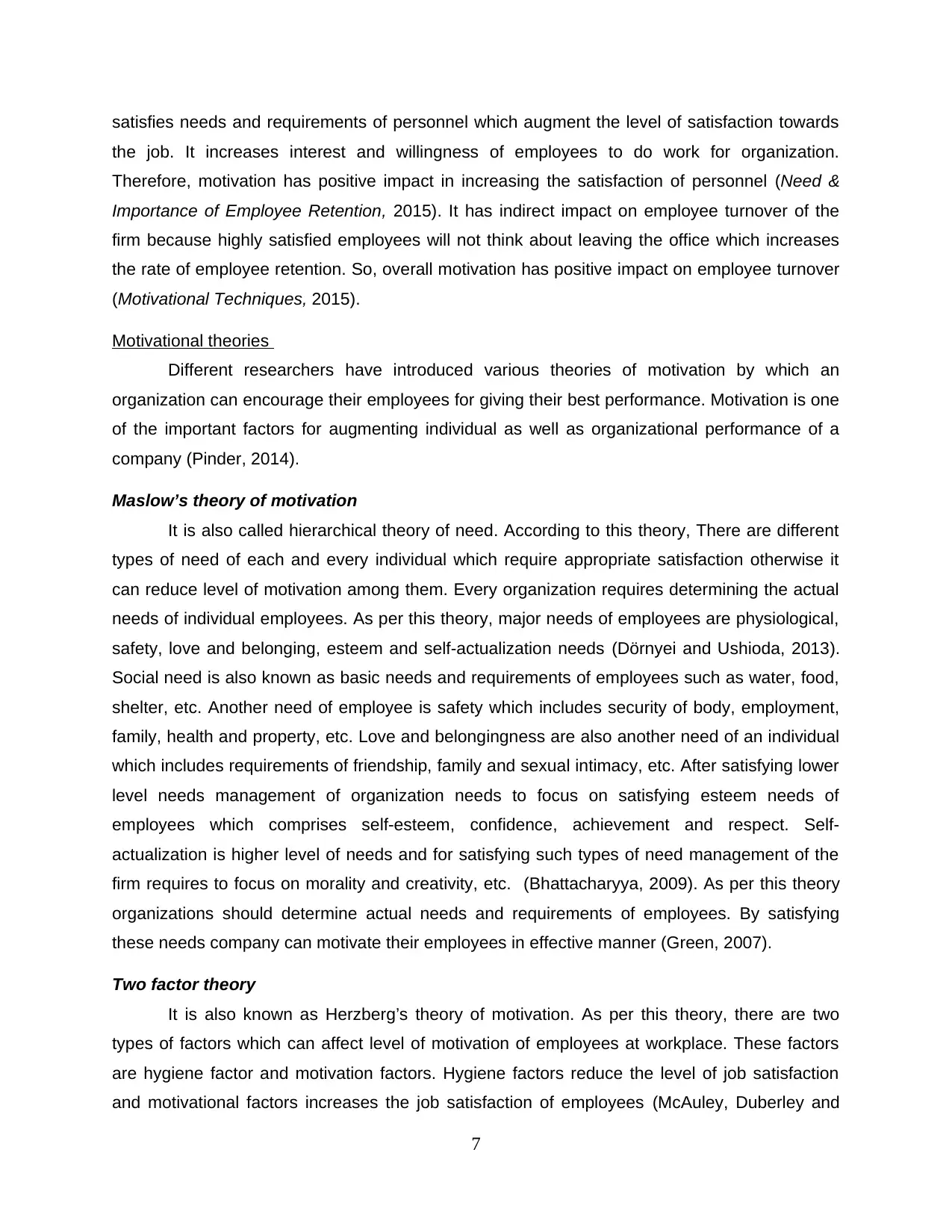
satisfies needs and requirements of personnel which augment the level of satisfaction towards
the job. It increases interest and willingness of employees to do work for organization.
Therefore, motivation has positive impact in increasing the satisfaction of personnel (Need &
Importance of Employee Retention, 2015). It has indirect impact on employee turnover of the
firm because highly satisfied employees will not think about leaving the office which increases
the rate of employee retention. So, overall motivation has positive impact on employee turnover
(Motivational Techniques, 2015).
Motivational theories
Different researchers have introduced various theories of motivation by which an
organization can encourage their employees for giving their best performance. Motivation is one
of the important factors for augmenting individual as well as organizational performance of a
company (Pinder, 2014).
Maslow’s theory of motivation
It is also called hierarchical theory of need. According to this theory, There are different
types of need of each and every individual which require appropriate satisfaction otherwise it
can reduce level of motivation among them. Every organization requires determining the actual
needs of individual employees. As per this theory, major needs of employees are physiological,
safety, love and belonging, esteem and self-actualization needs (Dörnyei and Ushioda, 2013).
Social need is also known as basic needs and requirements of employees such as water, food,
shelter, etc. Another need of employee is safety which includes security of body, employment,
family, health and property, etc. Love and belongingness are also another need of an individual
which includes requirements of friendship, family and sexual intimacy, etc. After satisfying lower
level needs management of organization needs to focus on satisfying esteem needs of
employees which comprises self-esteem, confidence, achievement and respect. Self-
actualization is higher level of needs and for satisfying such types of need management of the
firm requires to focus on morality and creativity, etc. (Bhattacharyya, 2009). As per this theory
organizations should determine actual needs and requirements of employees. By satisfying
these needs company can motivate their employees in effective manner (Green, 2007).
Two factor theory
It is also known as Herzberg’s theory of motivation. As per this theory, there are two
types of factors which can affect level of motivation of employees at workplace. These factors
are hygiene factor and motivation factors. Hygiene factors reduce the level of job satisfaction
and motivational factors increases the job satisfaction of employees (McAuley, Duberley and
7
the job. It increases interest and willingness of employees to do work for organization.
Therefore, motivation has positive impact in increasing the satisfaction of personnel (Need &
Importance of Employee Retention, 2015). It has indirect impact on employee turnover of the
firm because highly satisfied employees will not think about leaving the office which increases
the rate of employee retention. So, overall motivation has positive impact on employee turnover
(Motivational Techniques, 2015).
Motivational theories
Different researchers have introduced various theories of motivation by which an
organization can encourage their employees for giving their best performance. Motivation is one
of the important factors for augmenting individual as well as organizational performance of a
company (Pinder, 2014).
Maslow’s theory of motivation
It is also called hierarchical theory of need. According to this theory, There are different
types of need of each and every individual which require appropriate satisfaction otherwise it
can reduce level of motivation among them. Every organization requires determining the actual
needs of individual employees. As per this theory, major needs of employees are physiological,
safety, love and belonging, esteem and self-actualization needs (Dörnyei and Ushioda, 2013).
Social need is also known as basic needs and requirements of employees such as water, food,
shelter, etc. Another need of employee is safety which includes security of body, employment,
family, health and property, etc. Love and belongingness are also another need of an individual
which includes requirements of friendship, family and sexual intimacy, etc. After satisfying lower
level needs management of organization needs to focus on satisfying esteem needs of
employees which comprises self-esteem, confidence, achievement and respect. Self-
actualization is higher level of needs and for satisfying such types of need management of the
firm requires to focus on morality and creativity, etc. (Bhattacharyya, 2009). As per this theory
organizations should determine actual needs and requirements of employees. By satisfying
these needs company can motivate their employees in effective manner (Green, 2007).
Two factor theory
It is also known as Herzberg’s theory of motivation. As per this theory, there are two
types of factors which can affect level of motivation of employees at workplace. These factors
are hygiene factor and motivation factors. Hygiene factors reduce the level of job satisfaction
and motivational factors increases the job satisfaction of employees (McAuley, Duberley and
7
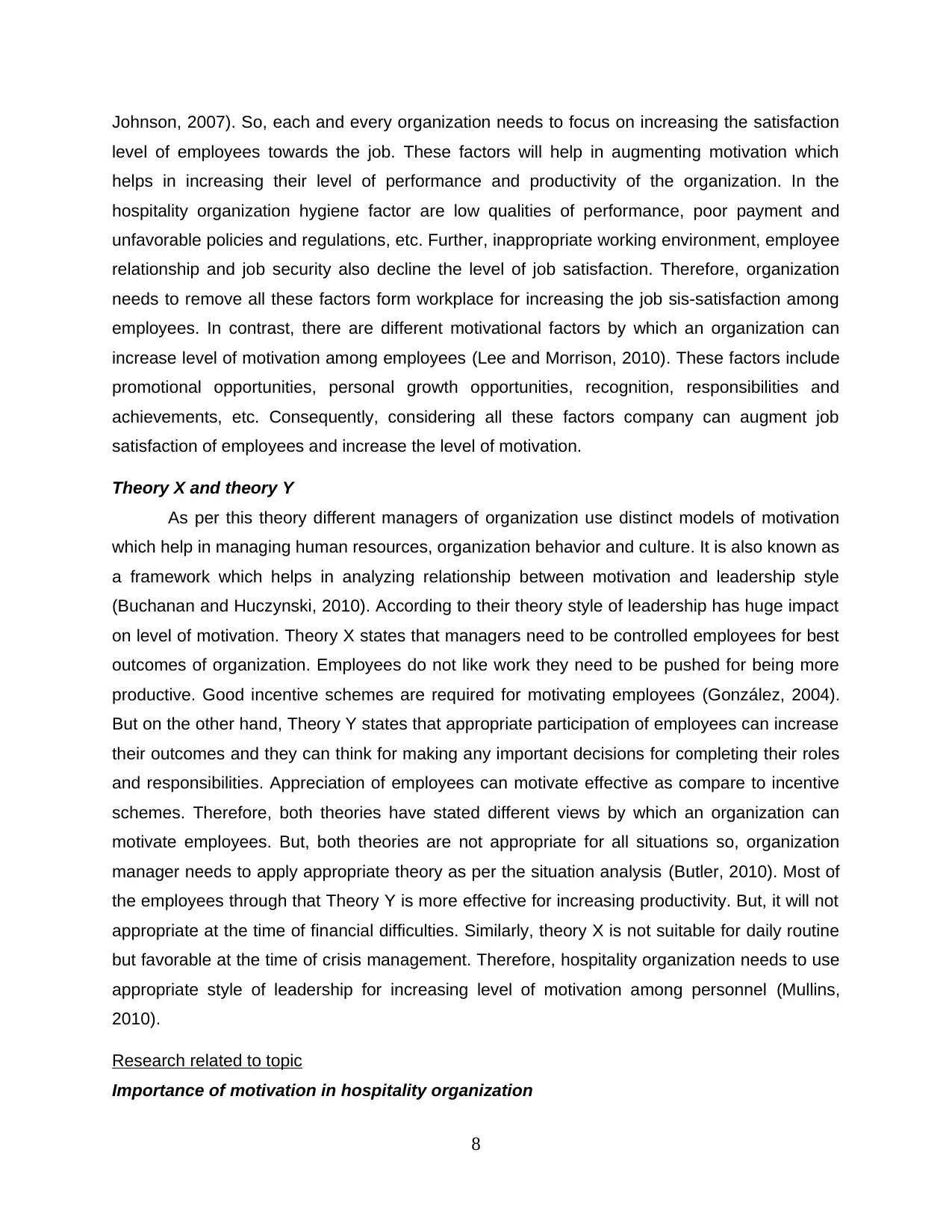
Johnson, 2007). So, each and every organization needs to focus on increasing the satisfaction
level of employees towards the job. These factors will help in augmenting motivation which
helps in increasing their level of performance and productivity of the organization. In the
hospitality organization hygiene factor are low qualities of performance, poor payment and
unfavorable policies and regulations, etc. Further, inappropriate working environment, employee
relationship and job security also decline the level of job satisfaction. Therefore, organization
needs to remove all these factors form workplace for increasing the job sis-satisfaction among
employees. In contrast, there are different motivational factors by which an organization can
increase level of motivation among employees (Lee and Morrison, 2010). These factors include
promotional opportunities, personal growth opportunities, recognition, responsibilities and
achievements, etc. Consequently, considering all these factors company can augment job
satisfaction of employees and increase the level of motivation.
Theory X and theory Y
As per this theory different managers of organization use distinct models of motivation
which help in managing human resources, organization behavior and culture. It is also known as
a framework which helps in analyzing relationship between motivation and leadership style
(Buchanan and Huczynski, 2010). According to their theory style of leadership has huge impact
on level of motivation. Theory X states that managers need to be controlled employees for best
outcomes of organization. Employees do not like work they need to be pushed for being more
productive. Good incentive schemes are required for motivating employees (González, 2004).
But on the other hand, Theory Y states that appropriate participation of employees can increase
their outcomes and they can think for making any important decisions for completing their roles
and responsibilities. Appreciation of employees can motivate effective as compare to incentive
schemes. Therefore, both theories have stated different views by which an organization can
motivate employees. But, both theories are not appropriate for all situations so, organization
manager needs to apply appropriate theory as per the situation analysis (Butler, 2010). Most of
the employees through that Theory Y is more effective for increasing productivity. But, it will not
appropriate at the time of financial difficulties. Similarly, theory X is not suitable for daily routine
but favorable at the time of crisis management. Therefore, hospitality organization needs to use
appropriate style of leadership for increasing level of motivation among personnel (Mullins,
2010).
Research related to topic
Importance of motivation in hospitality organization
8
level of employees towards the job. These factors will help in augmenting motivation which
helps in increasing their level of performance and productivity of the organization. In the
hospitality organization hygiene factor are low qualities of performance, poor payment and
unfavorable policies and regulations, etc. Further, inappropriate working environment, employee
relationship and job security also decline the level of job satisfaction. Therefore, organization
needs to remove all these factors form workplace for increasing the job sis-satisfaction among
employees. In contrast, there are different motivational factors by which an organization can
increase level of motivation among employees (Lee and Morrison, 2010). These factors include
promotional opportunities, personal growth opportunities, recognition, responsibilities and
achievements, etc. Consequently, considering all these factors company can augment job
satisfaction of employees and increase the level of motivation.
Theory X and theory Y
As per this theory different managers of organization use distinct models of motivation
which help in managing human resources, organization behavior and culture. It is also known as
a framework which helps in analyzing relationship between motivation and leadership style
(Buchanan and Huczynski, 2010). According to their theory style of leadership has huge impact
on level of motivation. Theory X states that managers need to be controlled employees for best
outcomes of organization. Employees do not like work they need to be pushed for being more
productive. Good incentive schemes are required for motivating employees (González, 2004).
But on the other hand, Theory Y states that appropriate participation of employees can increase
their outcomes and they can think for making any important decisions for completing their roles
and responsibilities. Appreciation of employees can motivate effective as compare to incentive
schemes. Therefore, both theories have stated different views by which an organization can
motivate employees. But, both theories are not appropriate for all situations so, organization
manager needs to apply appropriate theory as per the situation analysis (Butler, 2010). Most of
the employees through that Theory Y is more effective for increasing productivity. But, it will not
appropriate at the time of financial difficulties. Similarly, theory X is not suitable for daily routine
but favorable at the time of crisis management. Therefore, hospitality organization needs to use
appropriate style of leadership for increasing level of motivation among personnel (Mullins,
2010).
Research related to topic
Importance of motivation in hospitality organization
8
⊘ This is a preview!⊘
Do you want full access?
Subscribe today to unlock all pages.

Trusted by 1+ million students worldwide
1 out of 41
Related Documents
Your All-in-One AI-Powered Toolkit for Academic Success.
+13062052269
info@desklib.com
Available 24*7 on WhatsApp / Email
![[object Object]](/_next/static/media/star-bottom.7253800d.svg)
Unlock your academic potential
Copyright © 2020–2025 A2Z Services. All Rights Reserved. Developed and managed by ZUCOL.





